Home »
Misc »
How to improve layup in basketball
How to improve layup in basketball
Lay up techniques & exercises
- What is a lay up in basketball?
- How does a lay up work?
- Four types of lay ups
- Overhand lay up
- Underhand lay up
- The power move
- The up and under
- How do I practice the lay up?
- Common lay up mistakes
- Excercise to improve your jump
What is a lay up in basketball?
Approach the hoop while dribbling. Grab the ball with both hands, jump into the air and flick the ball onto the backboard and into the hoop. The lay up is one of the most fundamental offensive basketball manuevers and can be performed by beginners and professionals alike.
Due to the short distance to the basket, the basket lay up is a sure way to score points.
With the lay up, the correct step sequence and jump are most important.
Did you know?
The lay up and jump shot are the oldest shooting techniques in basketball.
How does a lay up work in basketball?
To learn the sequence of movements and steps, we recommend starting your lay up from a standing position with a single dribble.![]()
Ad
Here's how a basketball lay up works with your right hand:
Step 0: Positioning, 10 feet from the right of the basket
Position yourself about 10 feet from the basket, half way to the 3 point line, and run to the basket at a 45° angle.
Assume the starting classic shooting position.
Hold the ball close to your body with both hands at hip level.
Step 1: Dribble the ball with your right hand and place the left foot on the ground
Dribble with your right hand, the ball one step ahead of you. At the same time, step with your left foot.
Step 2: The right foot in front
Grab the ball with both hands, and hold it close to the right side of your body. Then take a step forward with the right foot.
3. Jump off with your left foot
Now take a step forward with your left foot and jump up and towards the basket.
At the same time, pull the right knee up. This helps stabilise your shot and accelerate you to the basket.
This helps stabilise your shot and accelerate you to the basket.
Important: When jumping off, focus on jumping upwards more than forwards.
Step 4: Guide the ball towards the basket and shoot
When taking to the air, bring the ball from the waist on the right side of your body. In one fluid motion, your right hand should be under the ball. Your left hand is kept to the side of the ball.
Once in the air, stretch out your right arm. At the apex, straighten your arm and elbow to shoot the ball towards the backboard. Your goal is the upper right corner of the square on the backboard.
In this video, you can see how a fluid lay up looks:
The lay up with the left hand works exactly the same but inverted, so start with your left foot, jump off with your right leg, and lay up with your left arm.
Our tip: Be sure to train both hands. This will help step up your game.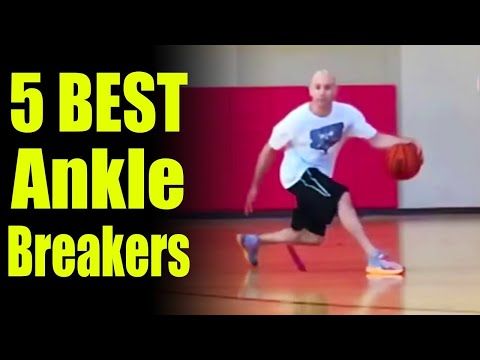
The following exercise helps beginners practice and internalise the lay up:
Here's another step by step guide on how to perform the lay up.
Step 1: Catch the ball landing with your left foot
Step 2: Step forward with your right foot
Step 3: Jump off with your left foot
Step 4: Drive forward with your right knee
Step 5: Simultaneously, bring the ball up with your right hand
Step 6: Lay it up softly
The 4 different types of lay ups
There are four different lay up techniques. The technique we've mentioned is simple and well suited for beginners. The other lay up techniques are more difficult and suited for experienced basketball players.
The overhand lay up
The original and simplest version of the basketball lay up is suitable for children and beginners.
The ball is thrown from the hand onto the backboard. The basketball lay up can be done with or without the backboard.
The basketball lay up can be done with or without the backboard.
Underhand Lay Up
This lay up variation is also called the finger roll and suited for experienced basketball players.
When laying up, the whole arm is stretched out. The hand is placed under the ball. Snap your wrist upwards so that the ball rolls off the fingertips. This will help the ball rise and fall softly into the basket.
The underhand lay up is:
- easier to block,
- for lay ups farther from the basket,
- only possible with a strong jump.
The following video shows how to do the finger roll with the underhand lay up:
The Power Move
The only difference between the overhand lay up and the power move is that you jump with both legs. This is where a strong jump is a necessity.
Ad
The Up and Under
The most difficult lay up variation is the up and under.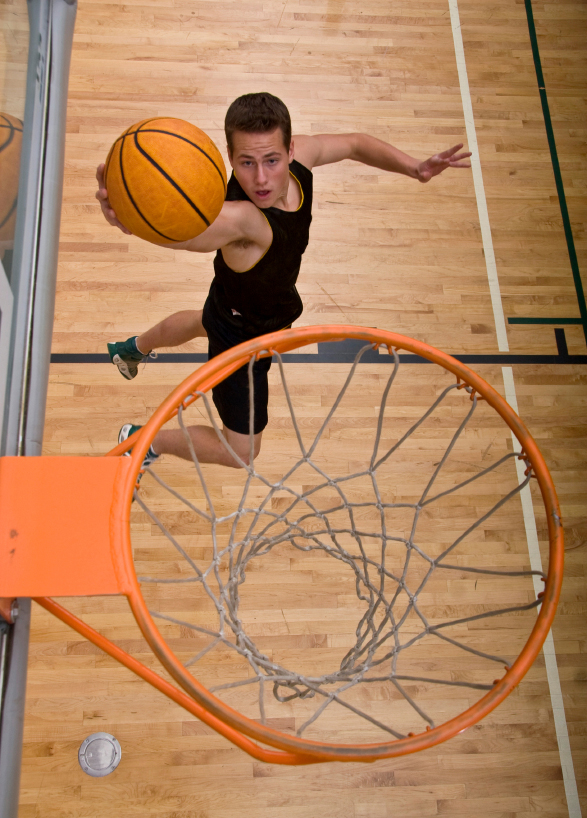 Here, the lay up is faked to bring the opponent out of position.
Here, the lay up is faked to bring the opponent out of position.
The player starts by jumping past the opponent, fakes the throw, bringing the ball around, and then lobbing the ball just before landing. In action, here's how the up and under lay up looks:
How do I practice the lay up?
The lay up is a very elaborate technique and can best be trained methodically in a series.
This means: For the lay up, first practice the individual steps and start with the simplest part. If you manage these steps individually, connect the steps in the correct order one by one.
Here's how the process works:
Step 1: Perfect your accuracy on the back board. Stand 45° from the backboard and practice.
Step 2: Practice the two-contact rule: Right - left - jump - back board shot.
Step 3: Add in a single dribble then repeat step 2.
Step 4: Add more dribbling in to feel more comfortable transitioning from dribbling to shooting.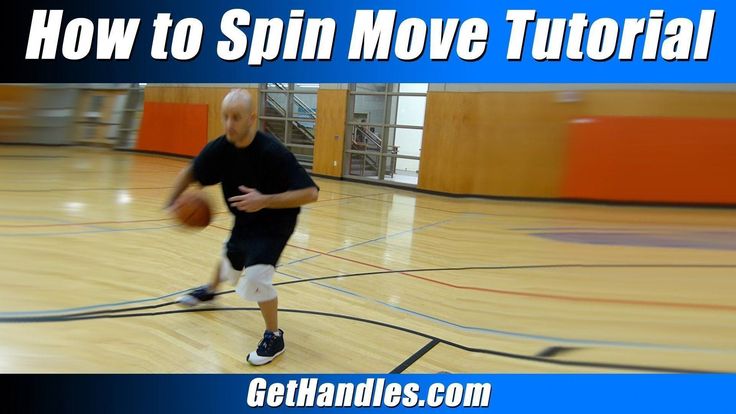 Then repeat step 2.
Then repeat step 2.
Step 5: Practice these steps with your weaker hand.
It takes a few training sessions before the basketball lay up can be used in a game.
Common lay up mistakes
Since the lay up is quite complex, problems are sure to arise in the beginning. Perfect practice makes perfect execution. Here's how to counteract typical mistakes:
Jumping with the wrong leg or approaching the basket with the wrong sequence of steps
- Go through the steps slowly, one at a time.
- Have your coach or teammate tell you right leg during the step sequence.
Missing arm extension with the standing shot
t- Train the standing throw for a while.
Jump is not high enough
- Pull the non-jumping knee actively up.
- Do excercises that isolate your jump.
Strength and jumping exercises for a better lay up
A strong jump is vital for a successful lay up. We'll show you how to practice this.
Important before starting your lay up exercises:
Warm up to get your muscles and joints ready for the strain. Be sure to plan sufficient breaks while practicing your jumping. Take care of your body to prevent injuries.
Genetically speaking, you can increase your jump height by a maximum of 10 to 20 percent. In addition to leg strength, a stable core is a necessity. A stable core allows you to better catapult yourself upwards, as your jump and core then work together to throw yourself up.
Along with jumping excercises, you can strengthen the core with the following excercises:
We recommend the following excercises if you'd like to train your jump.
Lunge Jumps
The jump lunge trains your explosive power:
- Place your feet hip wide.
- Take a large step back with your right foot.
- Knee is just over the ground.
- Jump and change legs.
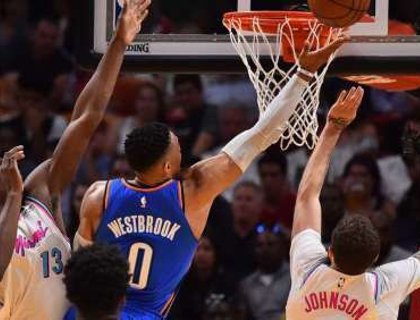
Half squats
Half squats train your jumping power from a squating position. This excercise is helpful because many basketball manuevers involve jumping.
.- Place feet hip wide apart.
- Bend your knees to go into a squating position.
- Expload upwards into the air.
Half deadlift
As with the last excercise, perform this exercise from a half squat. Place the weight on two boxes.
Note: Only perform this exercise once you've mastered the dead lift. If not, you could injure your back.
Box Jumps
To do box jumps, you'll need a stable box or bench.
- Stand upright with feet hip-wide in front of the box.
- Bend the knees until your thighs are parallel to the floor.
- Jump upwards and swing your arms forward.
- Land as gently as possible on the box in a squatting position.
- Jump back down gently to the ground.
Ball catching
This exercise trains your reflexes as well as your jump.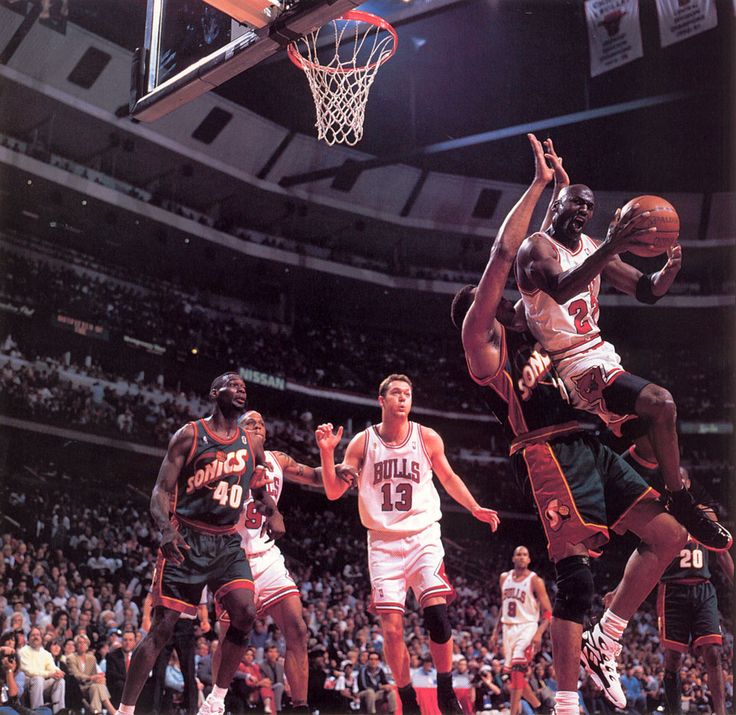
Throw the basketball against the backboard and try to catch it at the apex of its flight path.
One legged jumps
For this exercise, put one leg in the air, bend your knees and explode upwards. Once your leg is exhausted, switch legs. We recommend this excercise at the end of your training session.
Even more ideas for your next basketball practice
Still looking for more tips for your training? Sport psychologist and performance coach Sebastian Altfeld shows you how to effectively plan a basketball practice session. Or take a look at our other articles on the same topic:
- The Dunk
- Basketball Rules
- The Jump Shot
If you're still looking for the training jersey for you or your team, we recommend taking a look at our Online Shop. Or design your own jersey with our 3D Designer.
BS5 Pro Shooting Shirt
To our basketball shooting shirt »
B5 Pro Basketball Jersey
To our basketball jerseys »
Basketball Softshell XJS5 Pro Jersey
To our basketball team jackets »
Ad
Image credits: Image 1: lechatnoir/ Gettyimages/E+; Image 2: 4x6/Gettyimages/E+; Image 3: miodrag ignjatovic/ Gettyimages/E+
How to Do a Layup in Basketball (6-Step Guide)
If you want to win basketball games, your players must be able to finish at the rim consistently.
While knowing “how to do a layup” will sound easy to most players, it’s actually much more difficult than most people realize.
Think about it:
Players attack the hoop at varying speeds...
Players attack the hoop from many different angles...
And when they do get to the hoop, there’s usually a second defender waiting who will attempt to swat their layup into the 5th row.
Despite these challenges, players must learn how to score layups in a variety of situations if they want to experience individual and team success.
In this article, I’ll show you how.
I’ll start by teaching you (1) exactly what a layup is, (2) the six steps for how to do a layup, (3) the process for teaching layups to young kids, (4) the seven layup variations all players must master, before finishing with (5) some important layup tips.
Let’s get started…
What is a Layup?
Here’s the general definition most coaches would use:
“A layup is the action of a player dribbling towards the hoop, taking two steps, and then laying the basketball into the hoop off the backboard. ”
”
For a traditional layup — this is correct.
With that said…
There are MANY variations of a layup (I’ll share 7 of them with you later in this article) and no two in-game layups are identical.
There’s an endless number of situations a player will face when they attack the hoop in a 5-on-5 game.
The two things all layups do have in common:
(1) All layups are shots close to the basket
(2) All layups are worth two points
How to Do a Layup (6-Steps)
Now, let’s talk about how to do a layup correctly.
Learning correct footwork and layup technique is crucial for young players.
We don’t want players to develop poor habits that will be difficult to break out of as they get older and advance to higher levels of basketball.
For the purposes of this beginner’s guide, I’ll assume players are executing a regular right-handed layup.
Here we go:
1.
Eyes UpThe very first thing a player must do when they decide to attack the defense and finish with a layup is get their eyes up.
This is important for two main reasons:
a. To Lock onto the Target
The target they aim for will be either the hoop or the backboard depending on the player’s angle and speed.
Knowing which target to choose as the ball is released from the shooter’s hand is something players will get used to as they gain more experience.
b. To Read the Defense
Every time a player attacks the hoop, multiple defenders will step across to provide help and challenge the layup.
Players need to get their eyes up and use their peripheral vision to read these defenders.
This will help the player decide which layup variation will give them the best chance of scoring (or which teammate is now open to receive a pass).
2.
Outside Foot Step (Long)Remembering that we’re using a traditional, unguarded layup as the example for this blog post…
The first step a player makes as they pick up the basketball should be with their “outside” foot (closest to the sideline).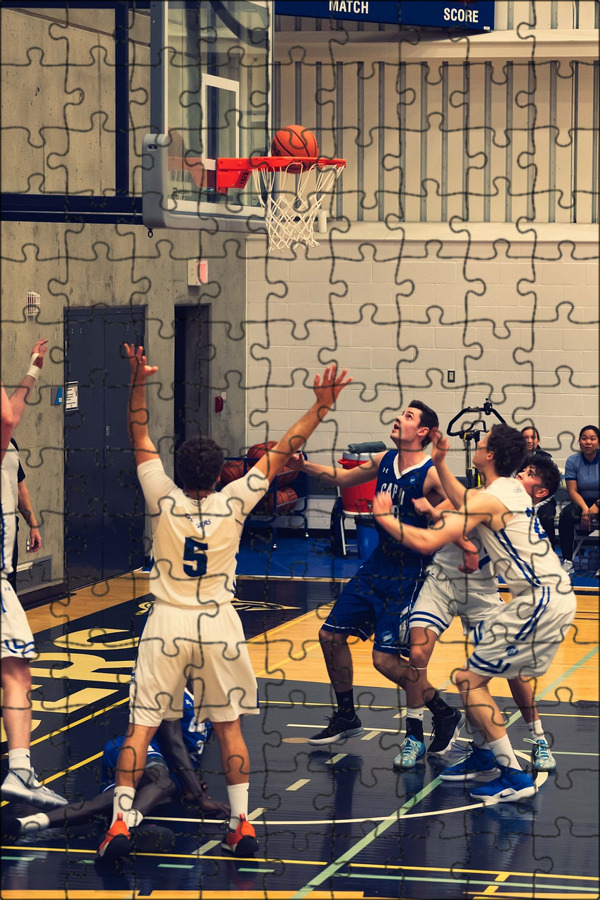
For right-handed layups, this is the right foot.
For left-handed layups, this is the left foot.
There are two important coaching points you should emphasize to players when you’re teaching them this step:
(1) Long Step
We want players to gain distance with the first step, and a long step also helps with the second point…
(2) Controlled
Players MUST be in control of their body as they perform their layup.
Too often we see young players sprint towards the hoop out of control and then launch the ball hard off the backboard.
Encourage them to slow down to increase their chances of scoring.
3.
Inside Foot Step (High)The second step of a traditional layup should be with the inside foot (closest to the middle of the court).
For right-handed layups, this is the left foot.
For left-handed layups, this is the right foot.
The key coaching point for the second step is the following:
“High Jump”
Along with ensuring players slow down and are in control of their layup, the emphasis to jump high will give young players the upward momentum they need to complete the layup.
This is done by driving the shooting-side knee up into the air as they jump off their opposite foot.
(Right knee on right-handed layups. Left knee on left-handed layups)
4.
Protect the BallIt’s crucial that a player protects the ball while attempting their layup.
Two things to watch out for:
a. Getting Stripped
Smart defenders will look to strip (steal) the ball from the offensive player during their two steps.
To prevent this from happening, the offensive player needs to (1) have strong hands and (2) keep the ball close to their body.
b. Getting Blocked
Tall defenders will attempt to block the shot during the upward shooting motion or as the ball leaves the offensive player’s hands.
To prevent this, the offensive players must use their non-shooting hands to protect the ball and increase the likelihood of getting fouled.
5.
Follow ThroughThe fifth step when learning how to do a layup…
Teach your players to bring the ball up above their head, extend their arm, and then flick their wrist to guide the basketball into the hoop.
The traditional overhand layup is very similar to a regular jump shot when it comes to this part of the layup technique.
Important Note:
If you’re coaching very young players, you might find they push the basketball up from their chest instead of bringing the ball above their head before shooting… this is due to a lack of strength.
This isn’t a big issue while they’re young, but make sure they’re growing out of this habit as they get older and stronger.
6.
Practice!Now that your players understand correct layup technique, it’s time they start doing some serious layup practice!
A few important things for coaches to think about:
a. Different Angles and Speeds
Run layup drills that involve players attacking the hoop from different angles and at different speeds.
- Left / right side
- Front of the rim
- Along the baseline
It’s important that they’re comfortable and confident driving to the hoop from anywhere on the court.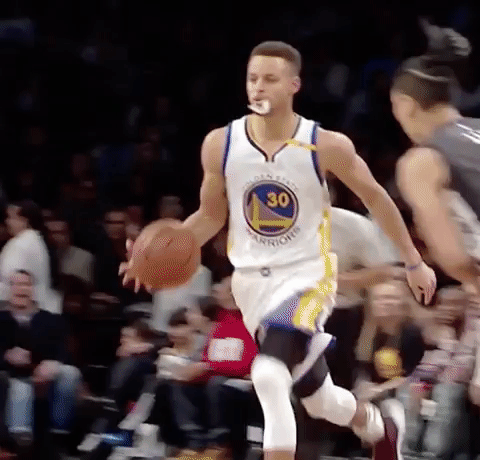
b. Right Hand and Left Hand
Allow players to mainly use with their dominant hand when they’re first learning how to perform a layup…
But make sure they start practicing with both hands once they understand correct technique and develop the strength to do so.
This is important to help them protect the ball and finish around good defenders as they get older and play against tougher competition.
c. Competition!
Almost immediately you should start running drills where players are required to attack the defense and finish with a layup against live defense.
Add both layup technique and layup competition drills to every practice.
For example:
Spend 10 minutes using a layup technique drill and then spend 10 minutes playing half court 2-on-1.
Your players might struggle against competition at first — they might commit a travelling violation, jump off the wrong foot, or rush their two steps — but they’ll benefit from the struggle in the long run.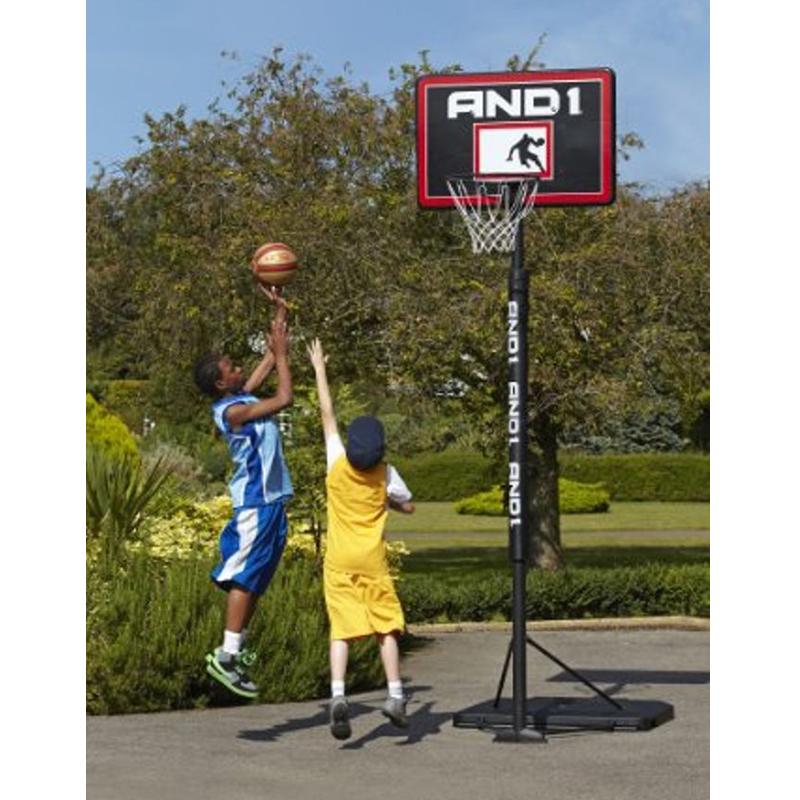
Teaching Layups to Kids - The Process
I’m guessing that most people reading this article are youth basketball coaches wanting to know the best way to teach layups.
If so, you’re in the right place.
I’m going to provide you with the step-by-step instructions.
These steps should be used to teach “overhand” and “underhand” layups to all players who have signed up to learn the game of basketball.
One final piece of advice before we get started:
Be patient.
These steps might seem simple to you… but to a young kid who’s trying to understand footwork, ball pickup, where to focus, distance, etc… it’s hard!
Let’s get stated…
1.
One-Step LayupThe first step is to start players on the low block.
Since most players are right-handed, I recommend starting on the right block since this will be most comfortable for them.
Give everyone a basketball, line everyone up behind the low block, and then get them to execute the following:
a.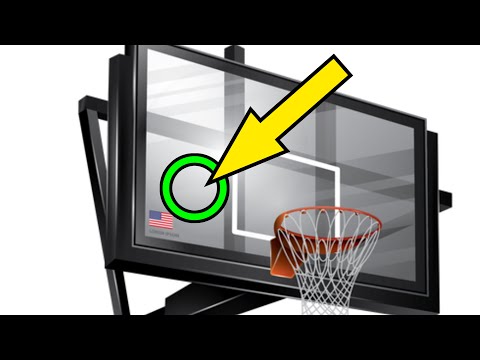 Start with feet together
Start with feet together
b. Take one step with their left foot (inside foot)
c. Jump off the left foot and shoot a layup off the backboard
2.
Two-Step LayupNext, let’s add a second step…
Get everyone to start one step back from the low block.
Reminding them that they don’t need to dribble the basketball yet, ask them to do the following:
a. Start with feet together
b. The first step is with their right foot (outside foot)
c. The second step is with their left foot (inside foot)
d. Jump off the left foot and shoot a layup off the backboard
Players grab their own rebound before joining the end of the same line.
3.
One-Dribble LayupNow let’s take another step back…
For the third step in this process, we ask players to take one dribble before completing their two steps and finishing with a layup.
Here are the instructions:
a. Start with feet together
b. The initial step is with their left foot. As this foot touches the ground, the player should take one dribble with their right hand.
As this foot touches the ground, the player should take one dribble with their right hand.
c. As the player catches the ball, they take their first layup step with their right foot (outside foot)
d. The second layup step is with their left foot (inside foot)
e. Jump off the left foot and shoot a layup off the backboard
4.
Multiple Dribble LayupThe final step when learning to shoot off the dribble requires players to retreat back behind the three-point arc.
From here, players will before multiple dribbles before gathering the ball, taking their two steps, and laying the ball in off the glass.
Here’s how it works:
a. Start behind the three-point line with a basketball.
b. Take multiple dribbles towards the hoop (eyes up!)
c. At the low block, take the first step with the right foot (outside foot)
d. The second layup step is with their left foot (inside foot)
e. Jump off the left foot and shoot a layup off the backboard
5.
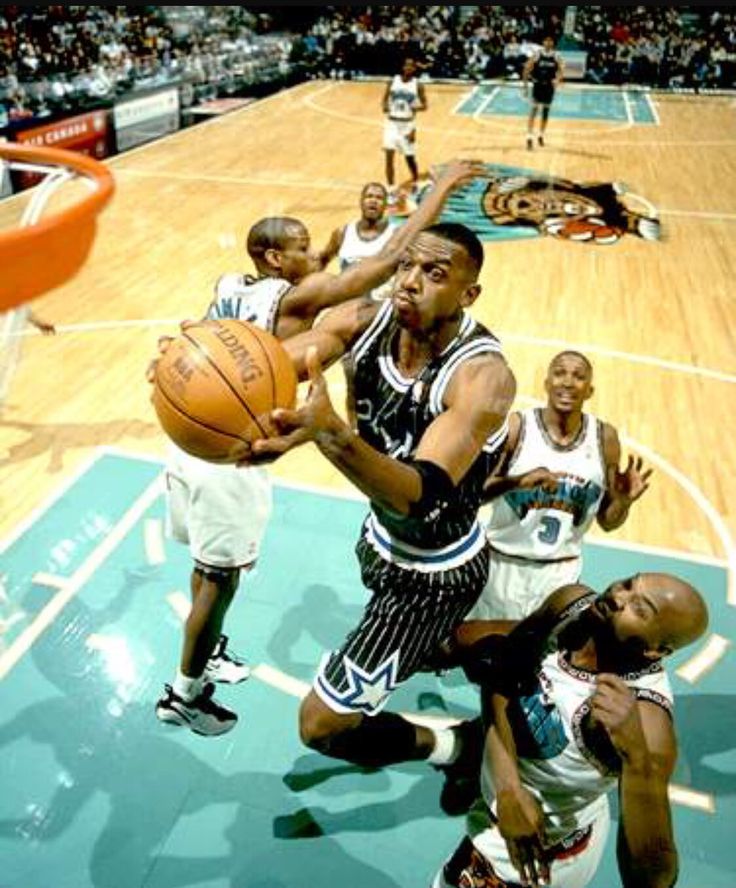 Catch and Layup
Catch and LayupAnother thing players must learn to do is receive the basketball while on the move and then finish with a layup without dribbling.
Players are put in this situation often during games…
They might make an off-ball cut to the hoop, receive a pass from a teammate on a fast break, or pass to a player in the post then cut off them.
My recommendation is to set up a quick “give and go” drill.
As follows:
a. Put one player on the free-throw line without a basketball.
b. Line everyone else up behind the three-point line with a basketball.
c. The player with the ball passes to the middle of the floor, sprints towards the hoop, and then receives the ball back for a no-dribble layup.
d. Change the “passer” every minute or two.
Video:
To help you better understand the whole process, check out this brilliant video from FIBA that shows the first four progressions:
Seven Layup Variations
As I spoke about in the step-by-step section, it’s important for players to master more than one type of layup.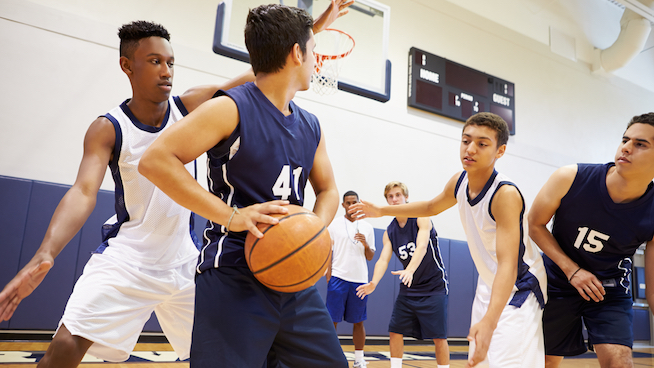
When you’re playing a real 5-on-5 game, there will be help defenders trying to block / alter your shot when you get to the hoop.
Being comfortable with a variety of layups will allow players to finish around any kind of defense that’s thrown at them.
Here’s the must-know list:
1.
Overhand LayupThis traditional layup is often the first one we teach young players. It’s similar to a regular jump shot in that a player gets their hand under the ball and “shoots” it off the backboard.
2.
Underhand Layup (Finger Roll)Also known as the “finger roll”. This involves players putting their shooting hand under the ball with their fingers facing forward, and then rolling the ball off their fingertips as they extend their arm to the hoop.
3.
FloaterThe floater is a great way for smaller players to score inside against bigger defenders. It involves a player “pushing” the ball up over the defense.
4.
Off-Foot LayupIf you really want to catch the defense by surprise, an off-foot layup should be in your bag of tricks. This involves jumping off the same foot you’re shooting with. For example, jumping off the right foot for a right-hand layup.
This involves jumping off the same foot you’re shooting with. For example, jumping off the right foot for a right-hand layup.
5.
Euro Step LayupThe Euro Step involves taking your first step in one direction, and then changing directions for your second step. This is a great way to step around defenders and change the angle as you complete a layup.
6.
Reverse LayupA reverse layup allows the offensive player to attack the hoop and finish on the opposite side of the rim. For players at high levels, the rim acts as protection from shot blockers.
7.
Power LayupA power layup involves performing a 2-foot jump stop before raising up to shoot. The benefit of this variation is it will give the player a stronger base, which is essential if you’re anticipating contact.
Advanced Layup Tips
Before you go, here are a few extra layup tips that will help players be more successful when attacking the hoop.
Some of the tips I’ve mentioned already throughout the article (but they need repeating), and some of them I’ve saved for this section.
Onward:
a.
Slow Down!One of the main reasons for missed layups at the youth basketball level is players are going way too fast.
If you were to spend just 2 minutes sitting on the sidelines of an U10’s game, and I guarantee you’ll see a 100mph fast break that results in the shooter slamming the ball off the backboard.
Encourage players to slow down, use a long first step to gain control of their body, and then jump high off the second step to finish.
Control is key.
b.
Create Space to FinishOnce a player gets past their defender off the dribble, teach them to step in front of the defender to “lock them behind”.
This creates space in front to finish with a floater or to draw the defense before dropping the basketball off to a teammate.
c.
Swish or Backboard?Coaches will often get players asking whether they should aim to swish the ball or use the backboard on their layups…
This is an impossible question to answer as every situation is different.![]()
The best advice you can give players is to practice finishing with a swish and off the backboard from all angles and at all speeds.
The more finishes a player is comfortable with, the more options they’ll have when confronted by a defender during games.
d.
Keep the Ball TightThis is something I spoke about in the “protect the ball” section above…
When going through the two-step motion of a layup, keep a strong grip on the ball and hold it close to your body.
Smart defenders will attempt to strip the basketball before you go up into the shooting motion of the layup.
e.
Don’t Be Scared of ContactGetting fouled on a layup will give you a chance at a three-point play (or free throws) and will push your opponent one step close to foul trouble.
But many young players are scared of contact.
To avoid contact or getting blocked, they angle away from the defense giving themselves a much more difficult shot attempt.
Encourage players to embrace contact and attack the defender!
f.
![]() Practice Against Real Defenders
Practice Against Real DefendersLearning layup technique is important, but all the individual layup practice in the world isn’t going to make you an elite finisher at the rim.
You must practice scoring against live defenders.
Once you’re comfortable with technique, it’s time to add defense take your finishing skills to the next level.
These will all help build the skills you need.
Conclusion
Learning how to do a layup is crucial for all young players.
Because they lack strength to make outside shots consistently, 90% of points scored in youth basketball are from layups.
Start by using the four progressions outlined in this article to teach them the basics, and then progress to teaching them the seven layup variations and also adding defenders.
If you do this well, your team should have no trouble attacking the hoop and scoring against any defense.
How to increase the jump? 5 tips
Every basketball player dreamed of jumping higher.
Every basketball player dreamed of jumping higher.
LOOKING AT MICHAEL, KOBE, VINC AND LEBRON? WANTED TO JUMP ALSO HIGH AND SCORE FROM THE TOP? PRACTICALLY EVERY BASKETBALL PLAYER WANTED THIS.
We asked our coach Sergey Nagorny to give 5 tips to help improve your jump.
We asked our coach Sergey Nagorny to give 5 tips to help improve your jump.
"The more power you have and the more you can apply power to the ground, the higher you can potentially jump. To increase your strength, you can choose any exercise: pulls, squats, lunges. Do what you like best and gradually increase the weight of the weights. "
Sergey Nagorny
Physical trainer training
Strength increase
Speed increase
"In addition to strength, the jump depends on speed, so this component also needs to be worked on. The easiest way is to sprint for short distances from 10 to 40-60 meters, and also work with sleds.![]() "
"
Sergey Nagorny
Physical trainer training
"This advice applies to both the workout itself and resting between sets, as well as recovery between sessions. People often start turning speed and jump workouts into endurance work. If you don't recover enough between sets and between workouts, then you you will never develop your jump to the maximum."
Sergey Nagorny
Physical trainer training
Proper rest
"Same skill as throw, snatch, etc. You have to be able to move efficiently. Jump more often - move more efficiently, but don't forget about recovery."
Sergey Nagorny
Physical trainer training
Jumping is a skill
Sleep more and eat right
"We are all looking for ways to recover better and use different modern gadgets to do this, but it all starts with simple things. Good sleep and proper nutrition are must-have items for a better recovery that everyone has at hand. "
"
Sergey Nagorny
Physical trainer training
SIGN UP
Coach: Sergey Nagorny
Professional athlete, works with athletes from Russia and the CIS. Performing dunker, creator and host of the Action video channel about athleticism in team sports.
Do you want to increase your jump and improve your athleticism? Look for "Basketball Athleticism" and "White Men Can Jump" workouts in our schedule and sign up.
If you liked the article and the workout, don't forget to share it with your friends.
MORE ARTICLES FROM
BLOG We write useful articles about basketball training, basketball shoes and everything related to this beautiful game.
LeBron's Secret of the Champions series you should watch
Top logos of current NBA players
Luka Doncic unveiled his new logo
Basketball games of our childhood
Who got into the NBA straight from school?
24 facts about Kobe Bryant
#THIS YOUR PLACE
in social networks:
Playing defense in basketball
Hello, dear visitors of the site basketball-training.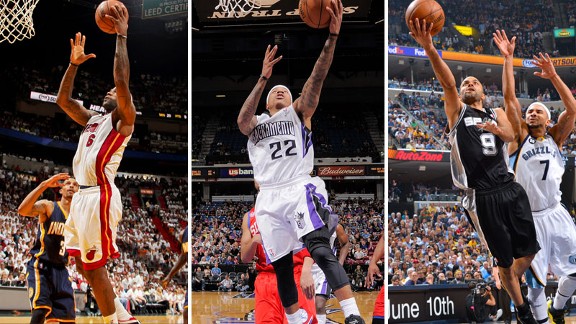 org.ua ! Today I want to share with you my observations and conclusions, which I received as a result of 's desire to improve his game in 's defense.
org.ua ! Today I want to share with you my observations and conclusions, which I received as a result of 's desire to improve his game in 's defense.
It so happened that the first few years of playing basketball (mostly on the street courts) my defense game consisted of constantly trying to cover the opponent's shot. Sometimes it worked, sometimes it didn’t work very well (I ended up either on the opponent’s back or on his head). It's a hell of a defense. A couple of years ago, I reconsidered my vision of playing defense, which I want to share with you.
Defensive Tips for
Basketball Players The first video that showed any hint of developing a basketball player's defensive skills was 's three-minute performance by Bruce Bowen on the TNT Fundamentals series. Then there was a short article on how to play defense against A. Gomelsky. Well, the last, but probably the most important training video was the company's products Better Basketball - Better 1 on 1 Defense .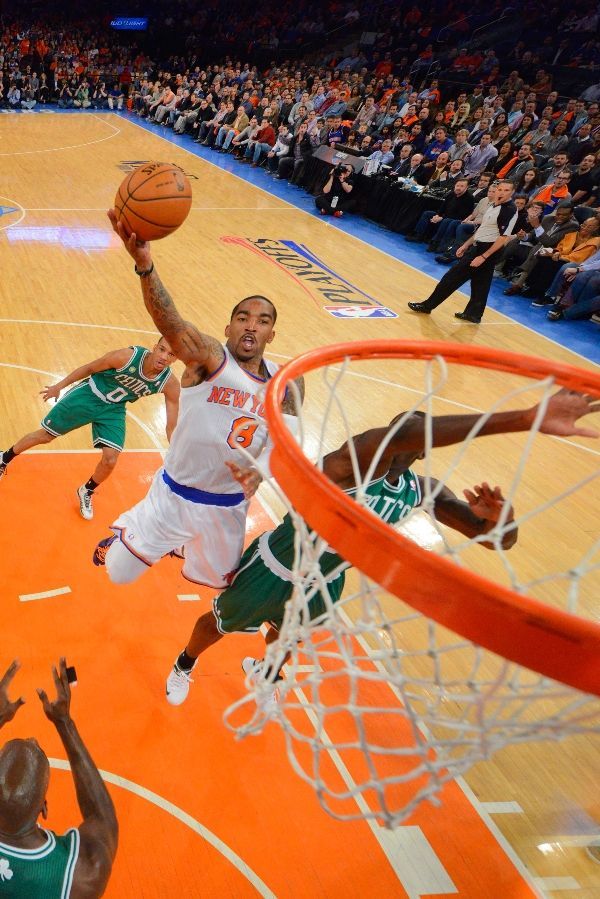 Even after skipping over half of what was said (some because of the language barrier, something because of banal restlessness) and putting even less into practice, I became much better at defending myself.
Even after skipping over half of what was said (some because of the language barrier, something because of banal restlessness) and putting even less into practice, I became much better at defending myself.
By the way, in this article everything will be exclusively about personal defense (and not a word about zone defense, although it is also worth writing about). So, I highlight the following stages of defense in basketball:
Stage 1: Defense against a player without the ball.
The essence of defense is to prevent the opponent from getting the ball . This is probably one of the most difficult stages, but also one of the most effective. Agree, it is difficult to attack without having the ball. So, this stage of defense is incredibly difficult, because you have to give a lot of strength, not to be fooled by movements of the body, head and legs. A good result of such a defense is that the player does not receive the ball throughout the attack.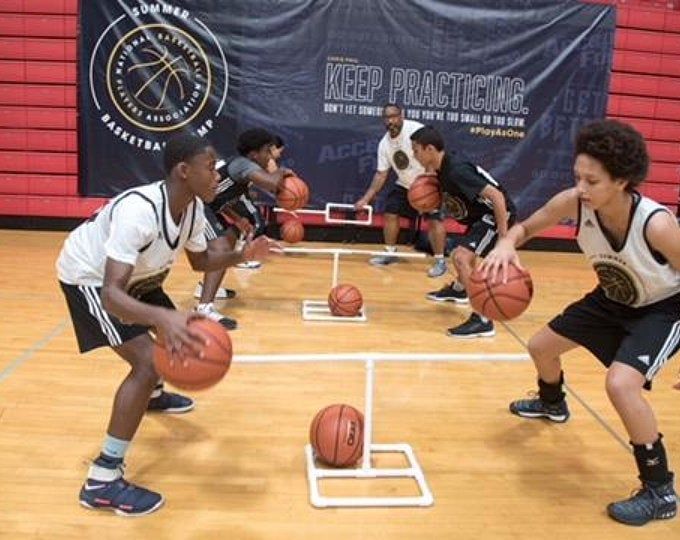 Also a good result if the ball is received, but: in an awkward position (far from the ring; in the corner of the court) or in the last seconds of the attack. Shitty result - the ball is received quickly and conveniently.
Also a good result if the ball is received, but: in an awkward position (far from the ring; in the corner of the court) or in the last seconds of the attack. Shitty result - the ball is received quickly and conveniently.
Stage 2: Defense against the player who received the ball.
When a player receives the ball, he is in the classic "triple threat position". This means that he can shoot the ring, pass or start the dribble. This means that we will have to confront all three threats at the same time. So, the best option is to take a position that will minimize the range of movement of the enemy. First of all, close its strong side from the passage by sitting a little to the side of it. As an option - from the side of his supporting leg; those. You will know the direction of his movement (he will not step with his supporting foot).
Let's conditionally divide the opponent's body into 2 levels: the first zone - to the waist; the second zone is above the belt. So, in order to start dribbling, the ball must be in the first zone. Both zones are suitable for a pass, and for a throw, the ball must go from the first zone to the second. I hope it's clear for now. So, one hand is playing with the bottom zone (preventing dribbling and low passing), the second is defending against a shot and a pass from the upper zone. Remember about the legs: with bent legs it is much easier and faster to make a jerk. If the legs are straight, then for a jerk they must first be bent.
So, in order to start dribbling, the ball must be in the first zone. Both zones are suitable for a pass, and for a throw, the ball must go from the first zone to the second. I hope it's clear for now. So, one hand is playing with the bottom zone (preventing dribbling and low passing), the second is defending against a shot and a pass from the upper zone. Remember about the legs: with bent legs it is much easier and faster to make a jerk. If the legs are straight, then for a jerk they must first be bent.
And one more piece of advice: pull the player all the time with your movements. Let the probability that these "ritual dances" help to knock out the ball will be small, but you will be able to knock the opponent out of his usual rhythm. And it's worth a lot!
Excellent defense: the ball is knocked out. Good defense - loss on pass, inaccurate pass, throw from an uncomfortable position.
Stage 3: Defending against the dribbler.
Assume that previous attempts to get possession of the ball failed and the opponent began to dribble. How to defend yourself then?
How to defend yourself then?
Let's not consider those situations in which the opponent is obviously weaker than you. It's just not interesting. The opponent is stronger, faster and jumpier than you - that's a good situation. Like I said, close his strong side. But if you don't know its strengths and weaknesses; you don’t know how to hold: from a throw or from a pass - that is, a good solution. We are trying to make sure that you are the leader. One side is obviously closed - and the player is deliberately skipped to the other. So you can not lose in the starting jerk and not guess the direction of movement: it can only go in one direction. Try to push the opponent with the ball to the end line, from where he can no longer comfortably attack the basket. Clamp into a corner, press to the line.
Again: Close one side tightly. Better - if it will be his forte; if you don’t know which one is strong, close your weak side and let defenses under your strong side. And a safety net: sometimes it's better not to let a player throw from an average distance. Allowing him to get under the ring. After all, there will be a safety net in the form of a “big”, which cannot be thrown so easily.
Allowing him to get under the ring. After all, there will be a safety net in the form of a “big”, which cannot be thrown so easily.
Stage 4: Maintenance completed.
It can be a double step and a throw, a simple throw after a stop, a jump, a pivot (turn), a series of displays, etc. Let's take a closer look at this.
Double step. Remember: he has 2 steps to complete the attack, and you have 2 steps to hit the ball down, and then another full step to block. I recommend doing this:
- A series of small touches to the ball during a double step (as if you were playing a drum). Thus, you will not knock out the ball, but you will disorientate it accurately. Yes, and in order to keep the ball, you have to make more.
- Trying to hit the ball from below! When hitting from above, there is a very high chance that you will hit your fingers - this is a foul. But from below: few people expect such a blow, few people close the ball from below.
 And taking the ball up for a throw, he will receive an additional impulse, the push of the ball - throwing it as it was previously thought would not be so easy.
And taking the ball up for a throw, he will receive an additional impulse, the push of the ball - throwing it as it was previously thought would not be so easy.
Little tip: after picking up the ball by the opponent, very often the ball goes down, and this is done strongly and abruptly. Just substitute okay from below at the level of the opponent's lower back: he himself will knock the ball against your hand. This is a very cool and often unexpected trick for the opponent.
- If it was a jump stop, or just a stop, then you need to get as close as possible and raise both hands vertically up. Now you can not be afraid of a foul.
Stage 5: Jump Shot.
It's good if you jump high and sharp - then try to block at the moment when the ball leaves the thrower's hand. You can just try to brush it off at the moment when the supporting hand is no longer involved in the throw, and the ball is on the wrist. I will not talk about how to block-shot, this is a topic for a separate article.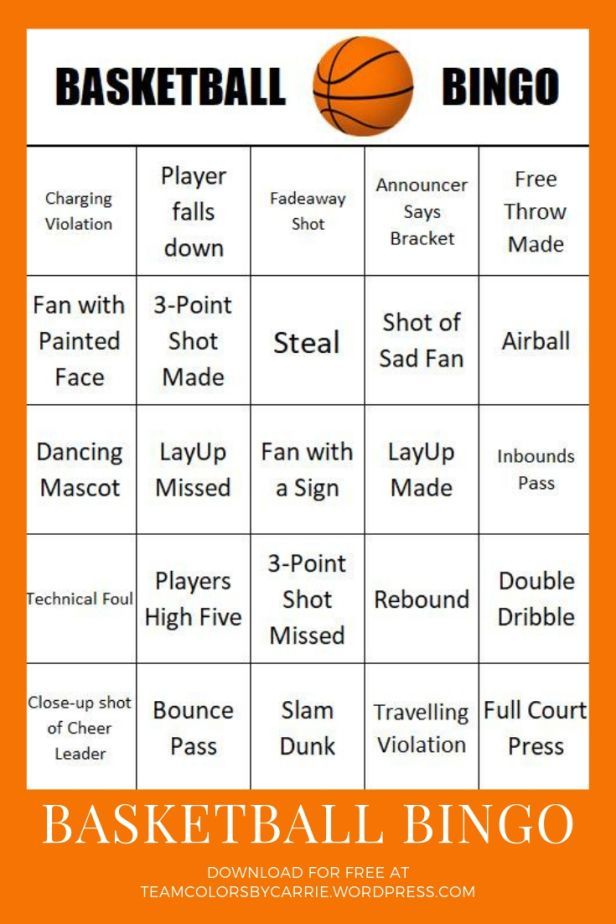
Remember that you can block the thrower's view with your hand: just don't poke it in the eyes, just bring it closer to the thrower's face. A good way (if you have not already jumped out for a block shot, and the throw is being made) is to simulate contact with various organs of the opponent (guys, you understand what I mean). Belly, solar plexus, groin - all this interferes with concentration at the time of the throw. Well, and often on street sites there is a clap of hands: at games they can give a foul, but on the street it can bring down that very concentration.
And finally, I suggest watching the old film , about the individual protection of basketball players, filmed in the USSR. There are some really useful things in there (the movie is old - so turn up the volume).
[youtube]9GMNCBu0Kes[/youtube]
Well, that's all, the main points that will help you defend better without any drastic changes in the game. I am sure that each of you found something useful in this article.